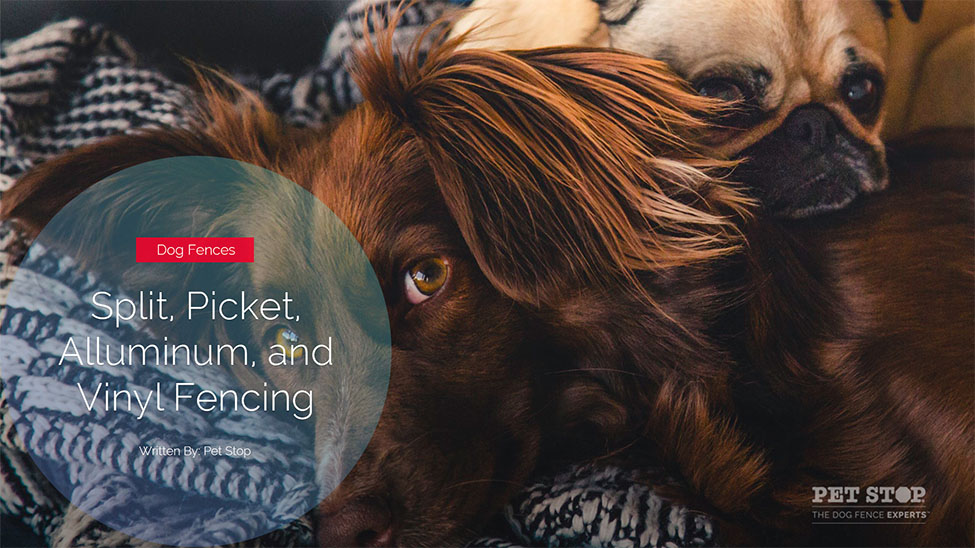Outdoor Versus Indoor Fences

Because you love your dog so much, you want to make sure he is safe, healthy and happy. One way to ensure your pet gets all three will involve finding a great dog fence. Selecting the best outdoor or indoor fence will likely happen at some point during your dog ownership tenure. There are so many options, and so many opinions, about which style, type, system, etc. that you are left conflicted and confused as to what is best for your fur baby. Our quick rundown of your outdoor and indoor dog fence options is sure to help clarify the right purchase for your pooch. Let’s get started.
Outdoor Dog Fences
The good, the not-so-good, and the downright ugly.
If good fences make good neighbors, then it should follow that good dog fences make good dogs, right? Finding a great puppy fence for your particular pooch means giving your pup a space where he can roam free, feel connected to his pack (that is, your family) and do his “job” of guarding his pack and territory. We will look at a few different outdoor dog fence types, then go inside and examine the best pens, gates and systems (maybe even a few crates) for a happy indoor dog. Underground outdoor and indoor dog fence systems, both wired and wireless, will be discussed.
1) Split-Rail Fences
These fences are a popular choice due to their lovely rustic look, and the ability to provide your dog with a view of what is beyond the fence. In order to keep in some more curious dogs, you may need to provide a layer of mesh or chicken wire as an extra layer of protection. Split-rail fences are good if your pup is unlikely to jump. Most animal behaviorists suggest a fence height of a minimum six feet when installing a dog fence, but take stock of your dog’s temperament and consider if he is a flight risk.
2) Picket Fences
Found in most suburban neighborhoods, picket fences, with their secure, snug slat construction and customizable tops can be a very secure boundary for your pet. Something to consider with these and other fences is this: if your dog is a dedicated digger, and many of them are, your fence needs to extend its underground reach at least six inches. Remember that number when you are measuring for this fence.
3) Aluminum Fences
Found in urban as well as suburban yards, the aluminum fence can offer a secure perimeter for your pup. Aluminum is rated for corrosion, strength, and end use, so consider the size and strength of your pooch, as well as weather conditions, when you choose your aluminum fence.
Popular modifications to the aluminum fence include “puppy pickets,” small, decorative rods attached to the bottom of the fence. Located between the larger posts, these smaller, inconspicuous pickets help curtail puppy and small dog “squeeze-through” escapes while enhancing the overall look of the fence.
4) Vinyl Fencing
You may not realize it, but your neighborhood is full of vinyl fencing. New techniques are creating a great, heavy-duty fence that is easy to clean and maintain.
The not-so-good and the downright ugly
Over the past few years, more and more people are abandoning their chain-link fences-especially dog owners. Frequently, dogs of all sizes will find ways to squeeze under a loose patch of fence, and they end up terribly scratched, injured, and worst of all, gone. Many HOAs forbid their use in their tracts, due to their unattractive appearance. If your chain link fence is currently your only barrier for your dog, consider adding mesh or other materials to create a more dog-proof and dog-friendly fence. It’s not worth the risk to your pet’s health and safety.
Making the underground visibly effective: underground fences
Since these types of fences are also hugely popular as indoor fences, please scroll down to read about it in our next section.
Indoor Dog Fences: The Future is Now
Indoor fences are becoming more and more innovative, and the options for your dog are many. First, we will look at traditional options for indoor containment.
1) Indoor Gates
One of the easiest barriers to put up in your home is a gate. Made from wood, vinyl, metal or plastic, these are a great option if you wish to confine your pet to (or keep him safely out of) a particular room. Some indoor gates even feature a small pet door, to allow smaller pets, such as cats, into a space off-limits to a messier or bigger family pet.
2) Indoor Freestanding Pens
Perfect for smaller dogs, but customizable to larger areas, these pens can be located in any room in the house, providing an approved area for playtime, while still letting your dog feel part of his “pack.” These also come in a variety of materials, similar to pet gates.
3) Wireless and Wired Dog Fences
These dog fence systems are exploding in popularity, and for good reason. They are effective, elusive, and easy to set up. Wireless indoor fences have two components: a signal transmitter and a receiver collar. Wired fences have a third part-the wire. These fences emit a barrier that, when breached, either emits a small alarm or tickles the pet via the receiver collar. This tickle is barely perceptible to your pet, and is a faint reminder of where he can and cannot go in the house.
The wires in the wired system can be bundled with other household cords, to blend in seamlessly with the look of the home.
Signal transmitters vary in size and signal strength, with some as small as a coaster and others the size of a smoke detector. This allows for greater flexibility in placement, either in the home or outside, and the transmitters are weather- and lightning-proof.
Both wireless and wired underground dog fences have their pros and cons. While the wireless fence uses an invisible Wi-Fi signal to create a boundary, it is usually not as large as the boundary from a wired system, so there are some considerations to make prior to making a final decision.
All in all, it is a great time to be a dog owner, and an even better time to be a dog. So many great, humane barrier systems exist, making life easier on everyone in the pack. Good luck and happy shopping!
 Pet Stop
Pet Stop Get a Free Quote
Connect with Your Local Pet Safety Experts at Pet Stop. Visit, call, or
chat with us – we’re here to help you create the ultimate safe haven for your pet.
Get a Free quote
Name *
Zip code where new fence is required *
What breed is your dog?
Preferred contact method *
Phone Number to Call/Text *
Address *
Stay Connected, Stay in Control
Brief introduction to the OT-300, highlighting remote control, real-time notifications, and easy setup through the Pet Stop Link App.
Download the App

